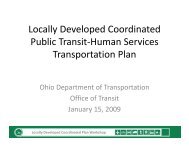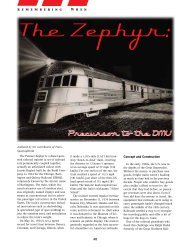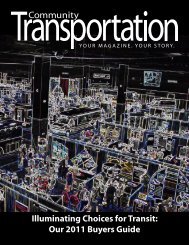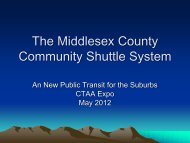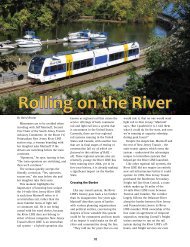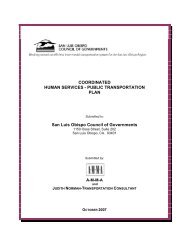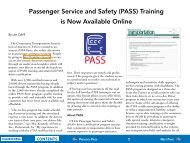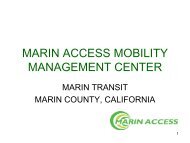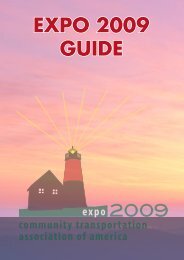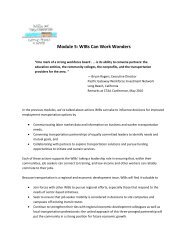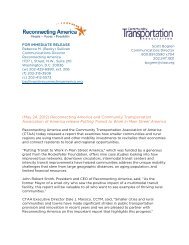FMCSA - The Community Transportation Association of America
FMCSA - The Community Transportation Association of America
FMCSA - The Community Transportation Association of America
Create successful ePaper yourself
Turn your PDF publications into a flip-book with our unique Google optimized e-Paper software.
Figuring Out the Federal Motor Carrier Safety Administration (<strong>FMCSA</strong>)Regulations: Do <strong>The</strong>y Apply and What to Do if the Answer Is “Yes”This fact sheet will provide an overview <strong>of</strong> federal regulation <strong>of</strong> interstate van and bus travel and whensuch regulation applies or does not apply to different classes <strong>of</strong> vehicles and situations. Thismemorandum only discusses passenger vehicles and not the transportation <strong>of</strong> property or hazardousmaterials. Included are references to statutes and regulations for easy reference. Also, it is importantto note that the regulations do not always accurately reflect the laws and this will be mentionedwherever appropriate, as will topics on which information is lacking. This fact sheet includes generalinformation and it is intended only as a starting point for legal consultation and research.Section I will explain the general rule <strong>of</strong> federal regulation <strong>of</strong> van and bus travel. Section II will discusswhat situations or vehicles are exceptions to <strong>FMCSA</strong> regulation. Section III will discuss thecircumstances in which particular regulations do not apply. Section IV will explain what must be donewhen the <strong>FMCSA</strong> regulations do apply.At the end <strong>of</strong> this memorandum is a sheet with quick information about van and bus regulations and alist <strong>of</strong> forms that transit providers are required to submit. <strong>The</strong>re is also an appendix with a detailed listand explanation <strong>of</strong> commercial zones.Determining whether an organization that engages in interstate travel must comply with federal motorcarrier regulations can be a complex task. <strong>The</strong> answer will depend on the type <strong>of</strong> operation, thecapacity <strong>of</strong> the vehicles, and even where the vehicles operate. In certain situations, some regulationsapply and others do not. And what does compliance or violation mean? Operators need to learn aboutfees, paperwork, and potential penalties.For answers to specific questions, consult a lawyer conversant in federal regulations or transportationlaw.I. What is the <strong>FMCSA</strong> and what do its regulations have to do with me?<strong>The</strong> Federal Motor Carrier Safety Administration (FMSCA) is the federal agency that regulates van andbus travel across state lines. It is an agency within the U.S. Department <strong>of</strong> <strong>Transportation</strong>. <strong>The</strong> <strong>FMCSA</strong>enforces safety regulations and sets operating standards. <strong>The</strong> agency is governed by federal statutes inTitle 49 <strong>of</strong> the U.S. Code and its regulations can be found in the Code <strong>of</strong> Federal Regulations and on theFMSCA website at http://www.fmcsa.dot.gov/rules‐regulations/administration/fmcsr/fmcsrguide.asp?section_type=A. Visit the FMSCA website for more information. It is a valuable resource.Interstate travel:<strong>The</strong> general rule is that any van or bus that crosses state lines, even to complete its trip within theoriginating state (49 U.S.C. § 13501), is subject to federal jurisdiction – meaning the federal governmentthrough the <strong>FMCSA</strong> has the authority to regulate. Once a vehicle moves people across state lines, it hasentered the realm <strong>of</strong> interstate commerce. Interstate commerce is a very broad term that includes bothfor‐pr<strong>of</strong>it and non‐pr<strong>of</strong>it transportation providers.
According to the <strong>FMCSA</strong>’s answers to its frequently asked questions (FAQs), interstate commerce meansthat “[e]ither the vehicle, its passengers, or cargo must cross a State boundary, or there must be theintent to cross a State boundary to be considered an interstate carrier.” Note that this is an extremelybroad definition that defines either the vehicle’s or the passenger’s itinerary.Where a provider operates exclusively in intrastate commerce—meaning wholly within a particular state– it must comply with applicable State and local regulations. Please note that every state is required tohave motor carrier regulations that are substantially identical to <strong>FMCSA</strong>’s; the primary distinction is thatstates are all over the board with regard to the definition, registration and oversight <strong>of</strong> intrastate motorcarriers.<strong>The</strong> only <strong>FMCSA</strong> regulations that are applicable to intrastate operations are: the commercial driver'slicense (CDL) requirement, for drivers operating commercial motor vehicles as defined in 49 CFR § 383.5;and controlled substances and alcohol testing for all persons required to possess a CDL. 1 (<strong>The</strong>re areadditional regulations applicable to carriers <strong>of</strong> hazardous substances.)Be aware that if an intrastate motor carrier has some kind <strong>of</strong> interlining or through ticketingarrangements with one or more interstate motor carriers, then the local carrier is regarded as beingengaged in interstate commerce and thus responsible for complying with <strong>FMCSA</strong> requirements. This iswhy Greyhound and Jefferson Lines require <strong>FMCSA</strong> registration as a condition <strong>of</strong> their contracts withsome local transit connections, even if the transit agency and its vehicles are nowhere near a state line.“Commercial motor vehicles”:To what providers and vehicles does this general rule apply? <strong>The</strong> answer is FMSCA has jurisdiction over“commercial motor vehicles,” which are defined in 49 U.S.C. § 31132(1) for purposes <strong>of</strong> passengertransportation as:a self‐propelled or towed vehicle used on the highways in interstate commerce to transportpassengers or property, if the vehicle ‐(A) has a gross vehicle weight rating or gross vehicle weight <strong>of</strong> at least 10,001 pounds,whichever is greater;(B) is designed or used to transport more than 8 passengers (including the driver) forcompensation;1 <strong>The</strong> reason why the federal government may regulate some aspects <strong>of</strong> transportation entirely within a singlestate is that the U.S. Supreme Court has interpreted the Commerce Clause <strong>of</strong> the Constitution to extend to thechannels and instrumentalities <strong>of</strong> interstate commerce as well as activities that in the aggregate substantiallyaffect interstate commerce. Gonzales v. Raich, 545 U.S. 1 (2005). For example, in Raich the Supreme Courtbanned the cultivation and sale <strong>of</strong> marijuana grown and sold solely within California for medicinal purposesbecause Congress already regulated that commerce in the Controlled Substances Act. <strong>The</strong> Court declared thatCongress need only possess a rational basis for concluding that an activity in the aggregate will substantially affectinterstate commerce, which marijuana cultivation and sale amounted to in Raich. According to this line <strong>of</strong>reasoning, it is well within Congress’ power to regulate commercial drivers’ licenses and testing drivers for drugand alcohol consumption even when vehicles never cross state lines.
(C) is designed or used to transport more than 15 passengers, including the driver, and is notused to transport passengers for compensation; … [Subsection D governs transportation <strong>of</strong>hazardous materials].“Designed or used” is a term employed in the U.S. Code and in many FMSCA regulations, including thesection quoted above. Remember that the higher number always applies. For example, a bus travellingacross state lines—in interstate commerce—that is designed for 40 passengers, but only carrying fourwill be considered designed or used for 40.Include the driver: A vehicle designed or used for a certain number always includes the driver!Just like every other set <strong>of</strong> legal rules, the <strong>FMCSA</strong> and regulations are not so straightforward. <strong>The</strong>re areexceptions to the rules and different categories <strong>of</strong> rules for different classes <strong>of</strong> vehicles.II.When the <strong>FMCSA</strong> regulations do not applyVehicles excluded from the “commercial motor vehicle” definition:<strong>The</strong> term “commercial motor vehicle” by definition excludes vehicles that carry fewer than ninepassengers (including the driver). Taxicabs and other vehicles with a smaller seating capacity areexempt from the FMSCA’s authority to regulate. 49 U.S.C. §§ 13506, 31132. <strong>The</strong> vehicle seatingthresholds in the regulations refer to the number <strong>of</strong> seats for which a vehicle is designed. <strong>The</strong>refore,minivans and SUVs designed to carry seven passengers and actually carrying seven passengers or fewer(including the driver) across state lines to bring workers to factories will not be federal subject to motorcarrier regulations. However, a van with 12 seats will meet the “commercial motor vehicle” definition ifused for the same purpose.Exceptions listed in 49 C.F.R. § 390.3(f):<strong>The</strong> FMSCA does not regulate certain limited categories <strong>of</strong> interstate van and bus travel. A list <strong>of</strong>exceptions is provided in the regulations at 49 C.F.R. § 390.3(f). However, the commercial driver licenseregulations and drug and alcohol testing regulations apply. <strong>The</strong> relevant exceptions regarding passengertransportation are:(f)(1) School bus operations – defined by 49 C.F.R. § 390.5 as the “use <strong>of</strong> a school bus to transport onlyschool children and/or school personnel from home to school and from school to home.”(f)(2) <strong>Transportation</strong> performed by the Federal government, a State, or any political subdivision <strong>of</strong> aState, or an agency established under a compact between States that has been approved by theCongress <strong>of</strong> the United States [not including non‐governmental recipients <strong>of</strong> federal funds];… … …(f)(6)(i) <strong>The</strong> operation <strong>of</strong> commercial motor vehicles designed or used to transport between 9 and 15passengers (including the driver), not for direct compensation, provided the vehicle does not otherwise
meet the definition <strong>of</strong> a commercial motor vehicle, except that motor carriers operating such vehiclesare required to comply with §§ 390.15, 390.19, and 390.21(a) and (b)(2). 2In subsection (f)(6)(i), quoted just above, the term “direct compensation” can be misleading. It is usedas the equivalent <strong>of</strong> interstate commerce, a very broadly defined term, and does not mean a for‐pr<strong>of</strong>itbusiness. For example, a non‐pr<strong>of</strong>it enterprise, such as a local Area Agency on Aging, that receives stateor federal funds and operates a van <strong>of</strong> up to 15 passengers (including the driver) to take older adults to asenior center across state lines is considered to be operating for direct compensation even if it receivesno private payments or reimbursement for services. (See pull‐out chart on last page.) Please note thatsubsection (f)(6)(i) does not exempt operators from all <strong>FMCSA</strong> regulations. <strong>The</strong> regulations for accidentregisters, motor vehicle identification reports, and motor carrier identification numbers apply tooperators <strong>of</strong> these vehicles.(Please note that 49 C.F.R. § 390.3 (f)(6)(ii), which created an exception for the 75 air‐mile radius“operation <strong>of</strong> commercial motor vehicles designed or used to transport between 9 and 15 passengers(including the driver) for direct compensation” is no longer in force. Section 4136 <strong>of</strong> the Safe,Accountable, Flexible, Efficient <strong>Transportation</strong> Equity Act: A Legacy For Users (SAFETEA‐LU) [Public Law109‐59, 119 Stat. 1144, 1745 (Aug. 10, 2005)] directed <strong>FMCSA</strong> to remove the 75 air‐mile radius standard.<strong>The</strong> <strong>FMCSA</strong> has not yet updated its regulations accordingly. 3 )Please note that school bus operations are exempt only for the purpose <strong>of</strong> transporting students andstaff to and from school.<strong>The</strong> government exception <strong>of</strong> subsection (f)(2) is also limited. A private party that contracts with a stateor federal agency is not covered. If the federal Bureau <strong>of</strong> Prisons enters into an agreement with acontractor to transport prisoners from a courthouse in Texas to a penitentiary in Kansas, the FMSCAlaws and regulations apply, but if that same agency performs this operation in house, then thegovernment as the transportation provider does not have to comply. However, even governmentemployees are required to adhere to regulations governing drug and alcohol testing and commercialsdrivers’ licenses.<strong>The</strong> laws and regulations governing interstate van and bus travel specifically grant the governmentalexception to units <strong>of</strong> state or local government that provide interstate transit service. Likewise, agovernment‐run transit system that has a contract with an interstate carrier to provide interstatetransportation still does not have to register with the <strong>FMCSA</strong>, but the interstate provider would berequired to register and comply with <strong>FMCSA</strong> regulations. However, a local non‐pr<strong>of</strong>it agency with thesame arrangement would be subject to <strong>FMCSA</strong> regulations.2 <strong>The</strong> <strong>FMCSA</strong> regulations listed in 49 C.F.R. § 390.3(f)(6)(i) that transit providers are required to follow are: §390.15, which requires assistance in State, local, or <strong>FMCSA</strong> investigations <strong>of</strong> accidents and mandates that van andbus operators maintain an accident register with particular information. Section 390.19 requires operators to filewith the FMSCA a Motor Carrier Identification Report, Form MCS‐150, or the Combined Motor CarrierIdentification Report and HM Permit Application, Form MCS‐150B for permitted carriers. Subsections 390.21(a)and (b)(2) require van and bus operators to mark their vehicles with “the motor carrier identification numberissued by the <strong>FMCSA</strong>, preceded by the letters “USDOT.”3 <strong>The</strong> statutes in Title 49 <strong>of</strong> the U.S. Code grant authority to the <strong>FMCSA</strong> to issue regulations. Where the regulationsand the statute conflict, the statute always controls.
Other exemptions in 49 U.S.C. § 13506:Exempt from FMSCA regulation under 49 U.S.C. § 13506 are hotel vehicles that provide transportationbetween a hotel and a local station, transportation “incidental to transportation by aircraft” or “in lieu<strong>of</strong> transportation by aircraft due to adverse weather conditions,” and operation <strong>of</strong> vehicles in Nationalparks or monuments.An important exemption in § 13506(10) is for vehicles carrying not more than 15 individuals in a single,daily roundtrip commute to and from work.Safety regulations apply even to § 13506 exempt vehicles and transportation. 49 C.F.R. § 390.5.Commercial Zones:<strong>The</strong> commercial zone exception in 49 C.F.R. Part 372 excludes from FMSCA regulation local interstatebus and van transportation in the United States in and around our cities, large and small. Thisexemption has nothing to do with how many passengers a vehicle is designed or used for and it does nottake into account the purpose <strong>of</strong> the transportation. See Appendix for more information about thegeographic definition <strong>of</strong> a commercials zone and cities specifically listed.]III.When some <strong>FMCSA</strong> regulations do not applyIf a business or non‐pr<strong>of</strong>it organization is transporting passengers across state lines, then certainregulations are applicable as long as the vehicle is “designed or used” to transport nine or morepeople, including the driver, and the vehicle or transit operation is not otherwise exempt.Depending on the vehicle’s capacity, again with the regulations always using the term “designed orused,” any operators that are not exempt from regulation must either comply with all or some <strong>FMCSA</strong>regulations. For vehicles designed or used for nine or more passengers and are not otherwise exempt,the regulations that must be followed provide for submission <strong>of</strong> motor carrier identification reports (§390.19), and required marking <strong>of</strong> CMVs (§ 390.21 (a) and (b)).Though certain vehicles or transit operations are listed as exceptions to <strong>FMCSA</strong> regulatory authority,they are subject to some regulations. An exception listed in 49 C.F.R. § 390.3(f)(6)(i) covers vehiclesdesigned or used to transport between 9 and 15 passengers, including the driver, AND not operated fordirect compensation. (<strong>The</strong>se would be vehicles that do not fall under the governmental, school bus,commercial zone, or other exceptions.) <strong>The</strong> <strong>FMCSA</strong> regulations with which transit providers mustcomply are §§ 390.15, 390.19, and 390.21 (a) and (b)(2). Section 390.15 requires assistance in State,local, or <strong>FMCSA</strong> investigations <strong>of</strong> accidents and mandates that van and bus operators maintain anaccident register with particular information. Section 390.19 requires operators to file with the FMSCA aMotor Carrier Identification Report, Form MCS‐150, or the Combined Motor Carrier IdentificationReport and HM Permit Application, Form MCS‐150B for permitted carriers. (Forms are discussed later.)Subsections 390.21(a) and (b)(2) require van and bus operators to mark their vehicles with “the motorcarrier identification number issued by the <strong>FMCSA</strong>, preceded by the letters “USDOT.”This one situation demonstrates why the regulations require careful reading. Here particular types <strong>of</strong>vehicles are listed as exceptions, but are actually not excused from all <strong>FMCSA</strong> regulations.
Process agent:A process agent is simply a person who serves as the agent <strong>of</strong> record in the event <strong>of</strong> any subsequentlegal action that arises in the operation <strong>of</strong> interstate transportation. 49 C.F.R. § 366.3 provides, “Allpersons … designated [as process agents] must reside or maintain an <strong>of</strong>fice in the State for which theyare designated. If a State <strong>of</strong>ficial is designated, evidence <strong>of</strong> his willingness to accept service <strong>of</strong> processmust be furnished.” <strong>The</strong>re are no other qualifications mentioned. <strong>The</strong> process agent does not have tobe an attorney.All organizations that apply for federal motor carrier registration must have an agent for service <strong>of</strong>process. Designations shall be made on Form BOC–3. It must include all States for which agentdesignations are required. Only one copy must be retained by the carrier or broker at its principal place<strong>of</strong> business. 49 C.F.R. § 366.2.<strong>The</strong> <strong>FMCSA</strong> publishes a list <strong>of</strong> “blanket process agents” on its website at http://www.fmcsa.dot.gov/registration‐licensing/licensing/agents.htm. <strong>The</strong>se agents will arrange process agents in any state for afee. Blanket process agents certainly make sense for motor carriers, such as owner operator truckingand charter bus companies, which operate in many or all 48 contiguous states. However, there is norequirement that a blanket process agent be used and it probably makes sense not to use one iftraveling in only a small number <strong>of</strong> states.Process agents charge an annual fee. For process agents that advertise on the Internet, these rangefrom $30 to $150.Applications:• New applicants must submit Form MCS‐150. This form must be updated every 24 months.• All New‐Entrant Motor Carriers beginning their operation on or after January 1, 2003, must alsonow file an MCS‐150A Safety Certification for Application for USDOT Number. A “New Entrant”is defined as a Motor Carrier not based in Mexico that applies for a USDOT Number in order toinitiate operations in interstate commerce.• New applicants must submit Form OP‐1(P) for operating authority.• This paper work must be accompanied by the registration fee <strong>of</strong> $300 unless a fee waiverapplies. 49 C.F.R. § 360.3(f). Apply for a fee waiver when applying for operating authority. <strong>The</strong><strong>FMCSA</strong> does not refund application fees.<strong>The</strong> <strong>FMCSA</strong> will waive the $300 filing fee for the OP‐1(P) application for transit benefit operators whoare grantees under 49 U.S.C. §§ 5307, 5310, or 5311. See 49 C.F.R. § 360.3(e)(1). <strong>The</strong> application papersmust be submitted by mail and not online. <strong>The</strong> online application process does not accommodate thisfee waiver, so applicants must mail the completed OP‐1(P) application form with “TRANSIT BENEFITOPERATOR” typed or printed at the top <strong>of</strong> page 1, in the box in Section III, and in the PaymentInstructions section. (This information is repeated later in the section discussing paperwork.)
For purposes <strong>of</strong> fee waivers, the terms "Federal government agency" or "government entity" do notinclude a quasi‐ governmental corporation or government subsidized transportation company. 49 C.F.R.§ 360.3(e)(1).All other operators must request reductions or waivers and demonstrate that the reduction or waiverwill be in “the best interest <strong>of</strong> the public” or that the applicant will suffer hardship if the request is notgranted. <strong>The</strong>re are no other factors given; nor is any specific documentation required. 49 C.F.R. §360.3(e).A request for a fee waiver or reduction must be submitted at the time the application to operateinterstate is filed. 49 C.F.R. § 360.3(e)(2)(i).Applications that include requests for fee waivers or reductions should be submitted by mail on paperso that requests for waivers may be fully explained.Insurance Requirements:Vehicles designed or used for between nine and 15 passengers, including the driver, to which the <strong>FMCSA</strong>regulations apply, must carry a minimum <strong>of</strong> $1.5 million insurance coverage. For vehicles designed orused for 16 or more, the insurance requirement is $5 million in coverage. 49 C.F.R. § 387.31. <strong>The</strong>se arerequirements for each vehicle.<strong>The</strong> forms regarding pro<strong>of</strong> <strong>of</strong> insurance are discussed at 49 C.F.R. § 387.39.Excused from federal insurance requirements is any “transportation service within a transit service areaunder an agreement with a Federal, State, or local government funded, in whole or in part, with a grantunder section 5307, 5310, or 5311, including transportation designed and carried out to meet thespecial needs <strong>of</strong> elderly individuals and individuals with disabilities; except that, in any case in which thetransit service area is located in more than 1 State, the minimum level <strong>of</strong> financial responsibility for suchmotor vehicle will be at least the highest level required for any <strong>of</strong> such States.” 42 U.S.C. § 31138(e)(4).Translation into plain English:Section 5307, 5310, or 5311 grantees are not required to comply with federal financial responsibilityrequirements, but they must obtain insurance in the highest amount required in the states in whichthe vehicles travel.It is best to obtain commercial insurance because the bond required <strong>of</strong> those who self insure is quiteonerous.V. Potential Penalties<strong>The</strong> maximum penalty is $11,000 for per violation, with each day a potential source for a newviolation. 49 C.F.R. § 387.41.
<strong>The</strong> Administrator <strong>of</strong> the <strong>FMCSA</strong> has discretion to impose a lower penalty, but there is no guarantee <strong>of</strong>such mercy. “In determining the amount <strong>of</strong> such penalty, the Administrator or his/her designee shalltake into account the nature, circumstances, extent, the gravity <strong>of</strong> the violation committed and, withrespect to the person found to have committed such violation, the degree <strong>of</strong> culpability, any history <strong>of</strong>prior <strong>of</strong>fenses, ability to pay, effect on ability to continue to do business, and such other matters asjustice may require.” 49 C.F.R. § 387.41.For employer responsibilities regarding commercial drivers’ licenses the civil penalty minimum is $2,750,the maximum is $25,000. <strong>The</strong>se may be imposed only after a conviction for a violation <strong>of</strong> §383.37(c).For a violation <strong>of</strong> operating authority, an out <strong>of</strong> service order may be imposed. Other criminal penaltiesfor fraud or perjury also apply.Each interstate operation must determine whether it is subject to the <strong>FMCSA</strong>’s jurisdiction and whetherit is required to comply all or some <strong>of</strong> the <strong>FMCSA</strong> regulations. <strong>The</strong>se can be difficult legal questions andshould be answered in consultation with an attorney. <strong>The</strong> likelihood <strong>of</strong> penalties being imposed and theamount <strong>of</strong> a penalty for a violation cannot be calculated here.On the next page is a removable sheet that displays quick information about <strong>FMCSA</strong> jurisdiction andregulations.
DO THE <strong>FMCSA</strong> REGULATIONS APPLY TO MY OPERATION?NOSMALL VEHICLES:DESIGNED FOR 8 OR LESS,SUCH AS TAXISSCHOOL TRANSPORTATION:TEACHERS OR STUDENTSTO OR FROM SCHOOLSMALL COMMUTER TRAVEL:15 PEOPLE OR LESSDAILY ROUNDTRIP COMMUTETO AND FROM WORKSOMETIMESFEDERAL GOVERNMENT, ASTATE, OR ANY POLITICALSUBDIVISION OF A STATECOMMERCIALZONE TRAVELVEHICLES DESIGNED FOR 9 TO 15WITHOUT DIRECT COMPENSATION(except that motor carriersoperating such vehicles arerequired to comply with §§ 390.15,390.19, and 390.21(a) and (b)(2))49 U.S.C. §§5307, 5310, 5311FUNDING(exception fromfederal insuranceminimums)YES16 +FOR‐PROFIT AND NON‐PROFIT TRANSPORTATION PROVIDERS THATCROSS STATE LINES(unless otherwise exempt)VECHICLES DESIGNED OR USEDFOR 9 ‐ 15FOR COMPENSATION(unless otherwise exempt)WHAT DOES COMPLIANCE MEAN?• FEDERAL INSURANCE MINIMUMS• DESIGNATION OF PROCESS AGENT• REGISTRATION FORMS• FEE• REQUEST FOR FEE REDUCTION OR WAIVER(submitted with registration forms)PENALTIES FOR VIOLATION OF <strong>FMCSA</strong> REGULATIONSFINANCIAL RESPONSIBILITY REQUIREMENTS – MAXIMUM PENALTY: $11,000 PER DAY PER VIOLATIONEMPLOYER RESPONSIBILITIES REGARDING COMMERCIAL DRIVERS’ LICENSES – CIVIL PENALTY MINIMUM$2,750, MAXIMUM $25,000 – ONLY AFTER A CONVICTION FOR A VIOLATION OF §383.37(c)VIOLATION OF OPERATING AUTHORITY – OUT OF SERVICE ORDERCRIMINAL PENALTIES FOR FRAUD OR PERJURYOTHER CIVIL AND CRIMINAL PENALTIES
<strong>FMCSA</strong> PAPERWORKMake sure that the applicant name is exactly the same in all paperwork!File these together: MCS‐150 form, MCS‐150A form, OP‐1(P) form, fee waiverrequest, and claim that FMSCA financial responsibility minimums do not apply.Keep a copy <strong>of</strong> all forms submitted.1. New applicants must submit Form MCS‐150 as part <strong>of</strong> the paperwork to obtain a USDOTNumber. This form must be updated every 24 months, according to the schedule listed in §390.19. (<strong>The</strong> month for subsequent submissions are determined by the USDOT number.)Be careful with question 23, which asks for the type <strong>of</strong> operation. Generally, a community orpublic transportation provider will be listed as “Authorized For‐Hire,” a non‐exempt MotorCarrier who receives compensation for transporting passengers. In contrast, social serviceproviders that transport their clients will be listed as Private Passenger (Non‐business). Forexample, a not‐for‐pr<strong>of</strong>it senior center that uses a bus to transport older adults to a shoppingcenter is a Private Passenger (Non‐business).2. New applicants must submit Form MCS‐150A Safety Certification for Application for USDOTNumber. This form need not be submitted if the company is an active Motor Carrier whichbegan operating prior to January 1, 2003.3. New applicants must submit Form OP‐1(P) for operating authority.<strong>The</strong> online application process does not accommodate a fee waiver, so applicants must mail thecompleted OP‐1(P) application form with “TRANSIT BENEFIT OPERATOR” typed or printed at thetop <strong>of</strong> page 1, in the box in Section III, and in the Payment Instructions section.4. <strong>The</strong> <strong>FMCSA</strong> filing fee is $300. However, this fee may be waived or reduced in the public interest.A written statement <strong>of</strong> reasons for waiving or reducing the fee must be submitted.5. To obtain the benefit <strong>of</strong> the exception from federal insurance minimums for vehicles for §§5307, 5310, or 5311 grantees, the forms must be mailed in on paper instead <strong>of</strong> filing online.A copy <strong>of</strong> the form to establish that you are a grantee under §§ 5307, 5310, or 5311 is notavailable online. It is available at CTAA. Please contact Sheryl Gross‐Glaser atgrossglaser@ctaa.org or 202.386.1669 to obtain a copy <strong>of</strong> the form.6. If mailing the OP‐1(P) form, then the MCS forms must both also be mailed together with theOP‐1(P) form and the filing fee or the request not to pay the filing fee.Mail completed forms together to:Federal Motor Carrier Safety AdministrationAttention: USDOT Number Application
1200 New Jersey Avenue SEWashington, DC 205907. Arrange for a process agent. Only requirement: Person chosen must reside or maintain an<strong>of</strong>fice in the State for which they are designated. Process agent for the state <strong>of</strong> principal place<strong>of</strong> business can be an employee or the owner <strong>of</strong> the transit entity. (May use a “blanket processagent.” <strong>The</strong>se are listed on the <strong>FMCSA</strong> website at http://www.fmcsa.dot.gov/registrationlicensing/licensing/agents.htm.)8. If applying by mail, the grant letter (sent by <strong>FMCSA</strong> in response to the OP‐1(P) form) shouldarrive via mail in approximately 4 weeks. This letter will include the MC (for motor carriers) or FFNumber. Once the MC number is received, you may submit form BOC–3 to designate a processagent. <strong>The</strong> form requires that the MC number be filled in.9. Other filings:BMC‐91 for pro<strong>of</strong> <strong>of</strong> InsuranceThis form is available from the insurance company to prove that the transportation provider hassufficient financial responsibility, meaning sufficient insurance coverage. <strong>The</strong> <strong>FMCSA</strong> does notprovide this form. Please allow 3‐5 working days for entry <strong>of</strong> insurance and process agentinformation.
APPENDIXCommercial Zones<strong>The</strong> commercial zone exception in 49 C.F.R. Part 372 excludes from FMSCA regulation local interstatebus and van transportation in the United States in and around our cities, large and small. This exceptionhas nothing to do with how many passengers a vehicle is designed or used for and it does not take intoaccount the purpose <strong>of</strong> the transportation.For purposes <strong>of</strong> school bus travel, the rule “shall not be construed as being inapplicable to motorvehicles being used at the time <strong>of</strong> operation in the transportation <strong>of</strong> school children and teachers to orfrom school, even though such motor vehicles are employed at other times in transportation beyond thescope <strong>of</strong> the exemption.” 49 C.F.R. § 372.103.First, Part 372, in sections 372.201 to 372.237 specifically lists these cities.Albany, N.Y.Beaumont, TexasCharleston, S.C.Charleston, W.Va.Lake Charles, La.Pittsburgh, Pa.Pueblo, Colo.Ravenswood, W.Va.Seattle, Wash.Washington, D.C.Syracuse, N.Y.Spokane, Wash.Tacoma, Wash.Chicago, Ill.New York, N.Y.New York and Washington demonstrate the usefulness <strong>of</strong> this exemption because these metropolitanareas span multiple states and jurisdictions. Interstate travel is an everyday occurrence for getting towork, schools, medical appointments and entertainment.Twin cities are considered one municipality for purposes <strong>of</strong> determining population and the geographicreach <strong>of</strong> a commercial zone. 49 C.F.R. § 372.221(a). Section 372.221(b) lists the following cities as twincities.Bluefield, Va.–W.Va.Bristol, Va.–Tenn.Davenport, Iowa, and Rock Island and Moline, Ill.Delmar, Del.–Md.Harrison, Ohio–West Harrison, Ind.Junction City, Ark.–La.Kansas City, Mo.–Kansas City, Kan.Minneapolis–St. Paul, Minn.St. Louis, Mo.–East St. Louis, Ill.Texarkana, Ark.–Texas
Texhoma, Texas–Okla.Union City, Ind.–Ohio<strong>The</strong> metropolitan areas listed above are not the only ones to which the commercial zone exemptionapplies. It also extends to two other types <strong>of</strong> geographic areas, first, consolidated governments (§372.223), and second, commercial zones (§ 372.241).Commercial zones are defined as including:(a) <strong>The</strong> municipality itself, hereinafter called the base municipality;(b) All municipalities which are contiguous to the base municipality;(c) All other municipalities and all unincorporated area within the United States which areadjacent to the base municipality as follows:(c)(1) When the base municipality has a population less than 2,500 all unincorporated areaswithin 3 miles <strong>of</strong> its corporate limits and all <strong>of</strong> any other municipality any part <strong>of</strong> which is within3 miles <strong>of</strong> the corporate limits <strong>of</strong> the base municipality,(c)(2) When the base municipality has a population <strong>of</strong> 2,500 but less than 25,000 allunincorporated areas within 4 miles <strong>of</strong> its corporate limits and all <strong>of</strong> any other municipality anypart <strong>of</strong> which is within 4 miles <strong>of</strong> the corporate limits <strong>of</strong> the base municipality.(c)(3) When the base municipality has a population <strong>of</strong> 25,000 but less than 100,000 allunincorporated areas within 6 miles <strong>of</strong> its corporate limits and all <strong>of</strong> any other municipality anypart <strong>of</strong> which is within 6 miles <strong>of</strong> the corporate limits <strong>of</strong> the base municipality, and(c)(4) When the base municipality has a population <strong>of</strong> 100,000 but less than 200,000 allunincorporated areas within 8 miles <strong>of</strong> its corporate limits and all <strong>of</strong> any other municipality anypart <strong>of</strong> which is within 8 miles <strong>of</strong> the corporate limits <strong>of</strong> the base municipality.(c)(5) When the base municipality has a population <strong>of</strong> 200,000 but less than 500,000 allunincorporated areas within 10 miles <strong>of</strong> its corporate limits and all <strong>of</strong> any other municipality anypart <strong>of</strong> which is within 10 miles <strong>of</strong> the corporate limits <strong>of</strong> the base municipality.(c)(6) When the base municipality has a population <strong>of</strong> 500,000 but less than 1 million, allunincorporated areas within 15 miles <strong>of</strong> its corporate limits and all <strong>of</strong> any other municipality anypart <strong>of</strong> which is within 15 miles <strong>of</strong> the corporate limits <strong>of</strong> the base municipality.(c)(7) When the base municipality has a population <strong>of</strong> 1 million or more, all unincorporatedareas within 20 miles <strong>of</strong> its corporate limits and all <strong>of</strong> any other municipality any part <strong>of</strong> which iswithin 20 miles <strong>of</strong> the corporate limits <strong>of</strong> the base municipality, and(d) All municipalities wholly surrounded, or so surrounded except for a water boundary, by thebase municipality, by any municipality contiguous thereto, or by any municipality adjacentthereto which is included in the commercial zone <strong>of</strong> such base municipality under the provisions<strong>of</strong> paragraph (c) <strong>of</strong> this section.For example, Omaha, NE, lies right near Council Bluffs, IA. Omaha’s population is approximately400,000, which would place it within subsection (c)(5) as a city <strong>of</strong> between 200,000 and 500,000 people.<strong>The</strong>refore, travel across states lines from within the corporate limits <strong>of</strong> Omaha, Nebraska to 10 milesaway and beyond 10 miles to the boundaries <strong>of</strong> any municipality within the 10 miles. Since CouncilBluffs is right across the river from Omaha, these two cities are within the same commercial zone eventhough they are across state lines from each other. However, for medical transportation fromBrookings, SD, population approximately 19,000, to a medical center at the University <strong>of</strong> Iowa in Iowa,City, the commercial zone exception would not apply because Iowa City is located beyond the limits fora commercial zone for a city the size <strong>of</strong> either Brookings or Iowa City.
Though somewhat confusing another list <strong>of</strong> cities is provided elsewhere in the regulations, in Appendix Fto subpart B <strong>of</strong> Part 390. Though there is much overlap with the cities mentioned in the lists set outabove, there are additional cities listed. Each <strong>of</strong> these areas is defined in detail within Appendix F.Los Angeles, Calif., and contiguous and adjacent municipalitiesPhiladelphia, Pa.Cincinnati, OhioBoston, Mass.Commercial zones <strong>of</strong> municipalities in New Jersey within 5 miles <strong>of</strong> New York, N.Y.Commercial zones <strong>of</strong> municipalities in Westchester and Nassau Counties, N.Y.,Tucson, Ariz.Albuquerque, N. Mex.Detroit, Mich.New Orleans, La.Portland, Ore.Vancouver, Wash.Memphis, Tenn.Houston, Tex.Pueblo, Colo.Louisville, Ky.Sioux City, IowaMetropolitan Government <strong>of</strong> Nashville and Davidson County, Tenn.Consolidated City <strong>of</strong> Indianapolis, Ind.Lexington‐Fayette Urban County, Ky.



